
James Dwight DanaFRS FRSE was an American geologist, mineralogist, volcanologist, and zoologist. He made pioneering studies of mountain-building, volcanic activity, and the origin and structure of continents and oceans around the world.

Clibanarius is a genus of hermit crabs in the family Diogenidae. Like other hermit crabs, their abdomen is soft-shelled and sheltered in a gastropod shell. Typically marine like all their relatives, the genus includes C. fonticola, the only known hermit crab species that spends all its life in freshwater. The feeding rates of Clibanarius species change with temperature which, given their broad distributions, may have considerable consequences for the stability reef systems as sea temperatures rise in the future.

Calanidae is the largest taxonomic family of calanoid copepods. It includes the genus Calanus, which may be the most abundant metazoan genus on Earth.
Allorchestes is a genus of amphipods with relatively small gnathopods, in the family Dogielinotidae; it contains the following species:
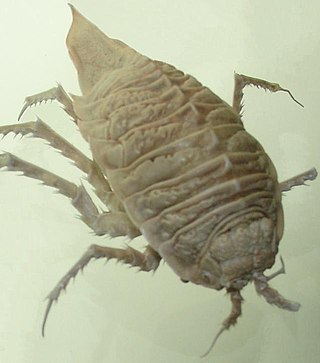
The Valvifera are marine isopod crustaceans. Valviferans are distinguished, however, by the flat, valve-like uropods which hinge laterally and fold inward beneath the rear part of their bodies, covering the pleopods. Some species are omnivorous, and serve as effective scavengers in the economy of the sea.
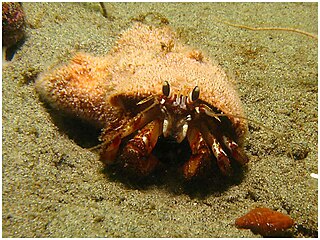
Pagurus is a genus of hermit crabs in the family Paguridae. Like other hermit crabs, their abdomen is not calcified and they use snail shells as protection. These marine decapod crustaceans are omnivorous, but mostly prey on small animals and scavenge carrion. Trigonocheirus and Pagurixus used to be considered subgenera of Pagurus, but the former is nowadays included in Orthopagurus, while the latter has been separated as a distinct genus.

Sapphirina, whose members are commonly known as sea sapphires, is a genus of parasitic copepods in the family Sapphirinidae.

Acanthastrea is a genus of large polyp stony corals in the family Lobophylliidae. The colonies are massive and usually flat. The corallites are either circular or angular in shape. The septa are thick near the wall of the corallite, becoming thin near the columella, and have tall teeth. The polyps are extended only at night.

Pontella is a marine copepod genus in the family Pontellidae. It is an organism that bears three lenses in the eye. The outer has a parabolic surface, countering the effects of spherical aberration while allowing a sharp image to be formed.

Copilia is a genus of copepods in the family Sapphirinidae. The eyes in members of this genus have two lenses, arranged like those in a telescope.
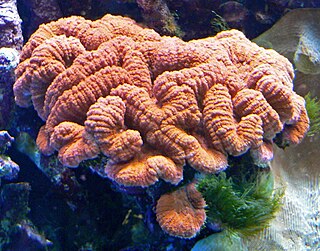
Lobophyllia, commonly called lobed brain coral or lobo coral, is a genus of large polyp stony corals. Members of this genus are sometimes found in reef aquariums.
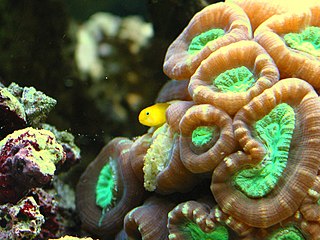
Caulastraea is a genus of stony corals in the family Merulinidae. Species of Caulastraea are commonly found in the aquarium trade under the names candy cane coral or trumpet coral.

Echinopora is a genus of stony corals in the family Merulinidae.

Favites is a genus of stony corals in the family Merulinidae. Members of this genus are native to the Indo-Pacific region and their ranges extend from the Red Sea through the Indian Ocean and Western Pacific Ocean as far as Japan, the Line Islands and the Tuamotu Islands.
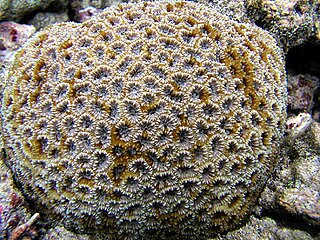
Dipsastraea is a genus of stony corals in the family Merulinidae. Members of this genus are native to the Indo-Pacific region. They are zooxanthellate corals.
Centropages is a genus of copepods in the family Centropagidae with 34 known marine species.

Temora is a genus of copepods in the family Temoridae. The World Register of Marine Species lists the following species:
Oithona is a planktonic crustacean genus found in marine, brackish, fresh water environments. Oithona has been described as the most ubiquitous and abundant copepod in the world's oceans. It was first described by Baird in 1843 using the species Oithona plumifera as taxon type.
Candacia is a genus of copepods in the order Calanoida. It is the only genus in the monotypic family Candaciidae.














